Tag Archive for: myeloma
What Should You Ask Your Doctor About Myeloma Testing?
What Should You Ask Your Doctor About Myeloma Testing? from Patient Empowerment Network on Vimeo.
Testing and test results may affect your myeloma care and treatment. Dr. Nina Shah, a myeloma expert, shares key questions to ask your doctor about testing and reviews testing techniques for myeloma.
Dr. Nina Shah is Associate Professor of Medicine in the Fepartment of Medicine at the University of California San Francisco (UCSF) and treats patients at the Hematology and Blood and Marrow Transplant Clinic at UCSF Helen Diller Family Comprehensive Cancer Center. Learn more about Dr. Shah, here.
Related Programs:

|
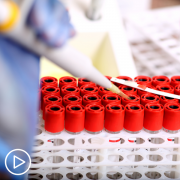
|

|
Transcript:
Katherine Banwell:
If a patient wants testing beyond the standard, what should they be asking their doctors for?
Dr. Shah:
Well, thankfully a lot of these tests can be done as a standard. We actually have some approved testing for it. So, the most important thing is to ask the doctor at all. For example, the patient may ask, 1.) “When will my next bone marrow biopsy be?” and 2.) “When I get that bone marrow biopsy, will you be looking at cytogenetics and FISH?” and 3.) “When you get the bone marrow biopsy, will you be also looking for minimal residual disease?” And finally, “What technique will you use to look for that minimal residual disease?” There are different ones that the patients might find useful to know about.
Katherine Banwell:
What are some of the different techniques?
Dr. Shah:
There are a variety of ways that we can look for minimal residual disease. One of them is called flow cytometry. What that is is you send all the cells that are in the bone marrow through a chute, and in that chute you can sort of detect one or however many cells that are – that have a specific characteristic on their cell surface.
You think of it as a bunch of balls with lollipops sticking out of it. And based on the characteristics of those lollipops, you can tell if there are any plasma cells or myeloma cells. Another thing we do with minimal residual disease, another technique, is called the next-gen sequencing or NGS.
And for that, we need to know the specific DNA sequence that is very personal to your myeloma cells. So, your particular plasma cell or the cancer cell will have a sort of sequence, a specific sequence that can be identified when you’re first diagnosed. And if you have access to that tissue, that can be sent off to the company, and they use that as sort of a template or a measure – an individual identification. And then, they scan the subsequent bone marrow samples against that to see if there’s any sequence that matches that original one, and that’s the way you can detect one in a million positive cells, if there are any.
How Is Minimal Residual Disease (MRD) Testing Used in Myeloma Care?
How Is Minimal Residual Disease (MRD) Testing Used in Myeloma Care? from Patient Empowerment Network on Vimeo.
Myeloma expert Dr. Nina Shah explains minimal residual disease (MRD) and how the results of this test may impact patient care and treatment.
Dr. Nina Shah is Associate Professor of Medicine in the Fepartment of Medicine at the University of California San Francisco (UCSF) and treats patients at the Hematology and Blood and Marrow Transplant Clinic at UCSF Helen Diller Family Comprehensive Cancer Center. Learn more about Dr. Shah, here.
Related Programs:

|

|

|
Transcript:
Katherine Banwell:
What is minimal residual disease testing, and when should it take place?
Dr. Shah:
Minimal residual disease is exactly what it sounds like. It’s the disease that you can’t see under the microscope, but it’s still there.
And I sort of equate it to the little deep food particles that are in a pot after you clean it and really, really scrub it, but still, something is in there. And that’s what it is for myeloma. And really, that depends on how sensitive your test is. We now know we can test for at least one in a million cells by some advanced techniques, and we like to test to see if there’s any disease left after certain treatments are done – for example, after a patient undergoes an autologous stem cell transplant.
Katherine Banwell:
What impact do results have on care decisions?
Dr. Shah:
Minimal residual disease testing can be useful for patients to understand the true burden of their disease. For example, it may be that there’s no more M-protein in the blood, or the light chains are normal, or even the bone marrow showed no plasma cells. But the minimal residual disease testing may show that, in fact, there are a few cells still in there, and that can help patients to decide, “Yes, I want proceed with maintenance therapy,” for example, or “No, I would not like to.” Although, we generally recommend it, patients like to have as much information as possible to make their decisions.
How Are Cytogenetics Used in Myeloma Care?
How Are Cytogenetics Used in Myeloma Care? from Patient Empowerment Network on Vimeo.
Myeloma expert, Dr. Nina Shah, explains cytogenetics and how results of these tests affect care and treatment for myeloma patients.
Dr. Nina Shah is Associate Professor of Medicine in the Fepartment of Medicine at the University of California San Francisco (UCSF) and treats patients at the Hematology and Blood and Marrow Transplant Clinic at UCSF Helen Diller Family Comprehensive Cancer Center. Learn more about Dr. Shah, here.
Related Programs:

|

|

|
Transcript:
Katherine Banwell:
What is cytogenetics, and how is it used in myeloma patient care?
Dr. Shah:
We use the term cytogenetics and FISH sort of interchangeably, and really what it is, is the DNA characteristics of the bad plasma cells. So, the myeloma cells, and a lot of them may have changes in their DNA that are what we call clonal, meaning that they’re in a significant percentage of those cancer cells, or they might be non-clonal, which are less significant. But it’s the way the DNA is put together or maybe cut and pasted so that it changes the characteristics and maybe the aggressiveness of the disease.
Katherine Banwell:
What is the goal of this in-depth testing? Are there specific markers you’re looking for?
Dr. Shah:
When we look for things like cytogenetics and send FISH testing, we look to see if patients have changes that might make their disease may be more aggressive.
For example, it may cause their plasma cells, the myeloma cells, to grow faster or more aggressively. So, we look for changes that might, for example, have a deletion of a certain chain that puts the brakes on tumors, or it may have a translocation, which is when the chains sort of do-si-do together and that makes the cells grow faster.
Understanding Your Role in Myeloma Treatment Decisions
Understanding Your Role in Myeloma Treatment Decisions from Patient Empowerment Network on Vimeo.
Many factors are considered when choosing a myeloma treatment. Dr. Nina Shah, a myeloma expert, reviews how treatment decisions are made and the patient’s role in deciding on an approach.
Dr. Nina Shah is Associate Professor of Medicine in the Department of Medicine at the University of California San Francisco (UCSF) and treats patients at the Hematology and Blood and Marrow Transplant Clinic at UCSF Helen Diller Family Comprehensive Cancer Center. Learn more about Dr. Shah, here.
Related Programs:

|

What Key Questions Should Myeloma Patients Ask About Treatment? |

|
Transcript:
Katherine Banwell:
What are the main factors that you take into consideration before a treatment approach is decided on?
Dr. Shah:
We always have to remember that treating a patient is also treating a person. So, it’s not just about what the disease the patient has but who the patient is. And so, we take into consideration goals that the patient as well as other health factors that may take – be taken into consideration. For example, the patient may have high blood pressure or a heart condition. But regarding the disease, we really also take into consideration what the profile of the disease is, maybe how much disease burden the patient has and some genetic factors that may impact our decision-making.
Katherine Banwell:
What is the patient’s role in treatment decisions?
Dr. Shah:
The patient should always be the center of the decision-making. I think that’s a really important thing for us to remember because ultimately, it’s the patient who has to make the decision and has to withstand the treatment. Alongside of that there may be some caregivers as well, but the patient has to, 1.) understand the disease, and 2.) understand the treatment options. So, it’s best if the patient has as much information as possible.
Katherine Banwell:
Are treatment considerations different for patients with relapsed disease?
Dr. Shah:
For patients with relapsed disease, there’s a lot of things to consider that may not have been true when the patient was first diagnosed. For example, you always have to think of what maybe the patient had as a prior – excuse me, as a prior treatment, and also how the patient tolerated it.
What You Should Know About Myeloma Clinical Trial Participation
What You Should Know About Myeloma Clinical Trial Participation from Patient Empowerment Network on Vimeo.
Myeloma expert Dr. Nina Shah shares her view on why patients should consider a myeloma clinical trial and provides advice for finding and participating in a trial.
Dr. Nina Shah is Associate Professor of Medicine in the Department of Medicine at the University of California San Francisco (UCSF) and treats patients at the Hematology and Blood and Marrow Transplant Clinic at UCSF Helen Diller Family Comprehensive Cancer Center. Learn more about Dr. Shah, here.
Related Programs:

Myeloma Treatment: When Should a Clinical Trial Be Considered? |

|

|
Transcript:
Katherine Banwell:
Why should a patient consider participating in a clinical trial?
Dr. Shah:
I am a huge fan of clinical trials, as you probably figured out. And the reason for that is that it’s the only way we know how to do things. And for everything we figured out about myeloma, it’s because patients participated beforehand in clinical trials. So, of course, it’s a way to pay it forward. But aside from that, there’s an experience that a patient can have on a clinical trial that is really unlike other experiences that patients may have. For example, they will be given the opportunity to understand a lot about their disease that maybe they may not have understood before, and they may have the opportunity to try a treatment that might be beneficial.
There are no guarantees in a clinical trial, and that informed consent procedure where the doctor tells you about the risks, benefits, and alternatives, should be very comprehensive and clear. But it does allow for patients to get access to something they may not have had before. And I think one of the other things that’s important is that it’s sort of a concierge service, I would say, with clinical trials, because you have to be monitored very closely. So, of course, all your symptoms have to be known. And you get a little bit more time, I would say, when you participate in a clinical trial because we really want to know the pluses and minuses of these treatments.
Katherine Banwell:
How can patients participate in research? Where do they start?
Dr. Shah:
Participating in research is a great opportunity for patients and something that we’re grateful for as myeloma physicians. There are many ways to look on various websites. There are things like SparkCures. There’s ClinicalTrials.gov. You can look at any academic website. Almost all advocacy groups also have opportunities for you to look at clinical trials.
And any time you get the opportunity to look at patient education sites, they may have a link for you to look for other clinical trials that might be relevant to your particular stage in disease or the particular kind of myeloma that you have. When in doubt, please, if you have a chance, talk to your local oncologist perhaps to maybe refer you to a myeloma specialist. We can do this by Zoom now, so there should be no reason that we can’t be a part of your care team at least for a consultation.
An Expert’s Hopeful Outlook on Myeloma Research and Treatment
An Expert’s Hopeful Outlook on Myeloma Research and Treatment from Patient Empowerment Network on Vimeo.
Myeloma expert Dr. Nina Shah shares why she’s hopeful about research and treatment, including immunotherapy and CAR T-cell therapy.
Dr. Nina Shah is Associate Professor of Medicine in the Department of Medicine at the University of California San Francisco (UCSF) and treats patients at the Hematology and Blood and Marrow Transplant Clinic at UCSF Helen Diller Family Comprehensive Cancer Center. Learn more about Dr. Shah, here.
Related Programs:
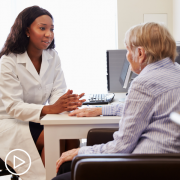
|

|

|
Transcript:
Katherine Banwell:
Is there emerging myeloma research that you feel patients should know about? And what are you excited about?
Dr. Shah:
There are so many aspects of myeloma treatment and the patient’s journey that we have been looking at. One of the things that I’m most excited about and I do a lot of research in is immunotherapy, which includes both CAR T-cell therapy as well as natural killer cell therapy and bispecific T-cell engager and other novel immunotherapies.
And I think these are interesting, because they allow for the patient’s own immune system sometimes to be used to kill the myeloma. And that’s something that is spring-boarding the way we treat myeloma to give patients better outcomes with less toxicity, if you can believe that. So, we’re really excited about that.
The other thing I’m really excited about is patient experience research that we’re doing. We now know that multiple myeloma patients live for maybe over a decade, and those patients are on a marathon of treatment; and how that treatment is a part of their life is very important in their experience as a patient. So, we’re trying to make that easier for patients as they go through, for example, transplants or maybe immunotherapy to give them more information, more control and more ability to talk about their symptoms with their provider and their care team.
An Expert Reflects on Hopeful Advances in Myeloma Treatment
An Expert Reflects on Hopeful Advances in Myeloma Treatment from Patient Empowerment Network on Vimeo.
Research is advancing quickly in myeloma. Donna Catamero, a nurse practitioner specializing in myeloma, shares why she is optimistic about the future of myeloma care and treatment.
Donna Catamero is Associate Director of Myeloma Translational Research at Icahn School of Medicine at Mount Sinai Hospital in New York City.
Related Programs:

|

Myeloma Treatment: When Should a Clinical Trial Be Considered? |

|
Transcript:
Katherine:
When it comes to myeloma research and emerging treatment options, what are you excited about specifically?
Donna:
So, I’m very excited about CAR T therapies, bispecific therapies and even trispecific therapies. And this is really harvesting a patient’s immune system to attack the myeloma cell. And I’m really excited about the results we’re seeing in the clinical trials. We’re seeing for a single agent therapy – and most patients know that with myeloma therapies they’re on combination therapies, but what we’re seeing is, with a single drug, that we can achieve very, very deep responses and very durable remission. So, patients who’ve had several relapses and are on their eighth, ninth, 10th line of therapy – we’re now able to achieve deep and durable remissions, which even five years ago was almost unheard of. So, this is really a very exciting time in myeloma research.
How Does Myeloma Testing Affect Care and Treatment?
How Does Myeloma Testing Affect Care and Treatment? from Patient Empowerment Network on Vimeo.
What is cytogenetic testing in myeloma? Donna Catamero, a nurse practitioner specializing in myeloma, describes this in-depth testing, including the FISH test, and how the results impact the care of patients.
Donna Catamero is Associate Director of Myeloma Translational Research at Icahn School of Medicine at Mount Sinai Hospital in New York City.
Related Programs:

|

Myeloma Test Results and Factors That Impact Treatment Decisions |

What Key Questions Should Myeloma Patients Ask About Treatment? |
Transcript:
Katherine:
Blood and urine tests, bone marrow biopsy and imaging tests are all standard following a myeloma diagnosis, but what about more in-depth testing?
Because the terminology around biomarker testing varies, can you help break this down for patients, and how this in-depth testing is referred to in myeloma?
Donna:
So, biomarkers is a term that is commonly tossed around in many different cancer diagnoses and it means different things. But in general, it’s characteristics that can inform us about a diagnosis, about a patient’s prognosis and about their response to treatment. So, this can include things that we measure in the bloodwork, in the urine, even imaging. These are all things or markers that we look at to determine a patient’s either, like I said, response or risk stratification.
Katherine:
What about cytogenetics? What is that exactly and does that fit under the umbrella of biomarker testing?
Donna:
Yeah, so cytogenetics is a genetic snapshot of a patient’s cancer. So, it will give us a sense of how the disease will – the characteristics of how it will behave. But again, it’s just a snapshot and it’s not a precise science but certain mutations or certain genes will kind of inform us like “This might be maybe a more aggressive form and we need to do X, Y and Z.”
Katherine:
Which of these more in-depth tests are necessary in myeloma? Let’s start with the FISH test.
Donna:
So, FISH is a cytogenetic technique. So, what we do is, when we do the bone marrow, we send that off and we look at the genetics. Like I said, it’s a snapshot. And certain mutations will put patients in different risk stratifications, so we normally do this at the time of diagnosis and then with each relapse.
Katherine:
It seems that all of the test results can aid in determining outpatient’s risk. So, why is risk stratification so important?
Donna:
So, risk stratification is important.
It will give us a sense of how a patient might respond to certain treatments. Maybe a patient won’t respond as well to a stem cell transplant as someone with standard risk. So, we take this into account, but in this current time, in 2021, we don’t typically change our treatments according to risk. That’s why clinical research is very important because we’re studying right now patients with high-risk cytogenetics, do they do they better on certain therapies.
Katherine:
How do the results of these tests affect treatment choice and prognosis?
Donna:
So, someone who might have high-risk cytogenetics, we might want to be maybe more aggressive with our therapy. So, we might change how we want to maintain a patient. Usually, after a stem cell transplant, we give patients maintenance therapies. So, patients who have high-risk disease, we might change our strategy and have a more aggressive regimen in that maintenance setting. And with patients with higher risk, we probably will monitor them very, very closely in case – looking for signs for relapse.
What Key Steps Should Follow a Myeloma Diagnosis?
What Key Steps Should Follow a Myeloma Diagnosis? from Patient Empowerment Network on Vimeo.
A myeloma diagnosis can be overwhelming, so where do you start? Donna Catamero, a nurse practitioner specializing in myeloma, shares key advice for patients and encourages self-advocacy to access the best care.
Donna Catamero is Associate Director of Myeloma Translational Research at Icahn School of Medicine at Mount Sinai Hospital in New York City.
Related Programs:

|

|

How Can Myeloma Patients Take an Active Role in Their Treatment and Care? |
Transcript:
Katherine:
Donna, would you please introduce yourself for us?
Donna:
I’m Donna Catamero. I’m a nurse practitioner at the Mt. Sinai Hospital in New York City, where I focus on clinical research and treatment of myeloma patients.
Katherine:
So, as a nurse practitioner specializing in myeloma, what’s your role in the healthcare team?
Donna:
So, I have several roles. So, the first role is caring for multiple myeloma patients, in particular, treating patients on clinical trials, managing their side effects, managing their treatment. My other role is a nurse educator. So, I help train our nursing staff and our research staff on myeloma, new therapies, “Myeloma 101”. So, I really help train and on-board our new staffing.
Katherine:
Excellent. When first diagnosed with myeloma, what three key pieces of advice do you have for patients and caregivers?
Donna:
So, number one is be your best advocate. So, learn everything you can learn about your disease. Learn about the treatments, the side effects, the treatment schedules. Don’t be afraid to ask questions and it’s okay to ask a question multiple times because we might not commit it to memory. So, learn as much as you can; learn how the drugs work. That’s why I’m saying knowledge is power and really, knowledge will lead to you being your best advocate.
And number two, it’s okay to have a second set of ears with you. So, sometimes the situation might be overwhelming and we might not hear or understand what’s being told to us. So, it’s important to have someone, a loved one, a caregiver, with us, so that they can also hear what the healthcare team is telling them. And I know in the day and age of COVID, there may be restrictions for visitors in the healthcare setting, but we can do recordings. We can have loved ones on the phone, so that they can hear what’s being told. And number three, is do not be a martyr. There’s no need for anyone to suffer.
If you’re in pain, let your team know. We can provide a lot of supportive care and get you through the most difficult times of your diagnosis.
Katherine:
Why is it important that patients engage in their care and treatment decisions?
Donna:
We have many options we can offer patients. Back in the day when I first started in my nursing career, we had only a handful of treatment options for patient. Now, we have an entire toolbox of treatments we can offer patients. So, it’s important to understand the treatments, the side effects, the schedule, and see if that aligns with your treatment goals so that this way you can make a very informed decision.
Myeloma Research: What’s the Latest Treatment News?
Myeloma Research: What’s the Latest Treatment News? from Patient Empowerment Network on Vimeo.
Myeloma expert Dr. Rafael Fonseca shares updates from recent conferences and provides tips to help you stay up-to-date on myeloma research developments.
Dr. Rafael Fonseca is the interim director of Mayo Clinic Cancer Center and serves as the director for Innovation and Transformational Relationships at Mayo Clinic in Arizona. Learn more about Dr. Fonseca here.
Related Programs:

How Can Myeloma Patients Take an Active Role in Their Treatment and Care? |

Myeloma Treatment: When Should a Clinical Trial Be Considered? |

An Expert’s Take on Promising Myeloma Treatment and Research |
Transcript:
Katherine:
Dr. Fonseca, have there been any recent developments in myeloma treatment in research that make you hopeful?
Dr. Fonseca:
Absolutely. I would say that the one area of work that makes me most hopeful is what we’re seeing with immunotherapy. We have seen that both as the ASH meeting, as well as the ASCO meeting in this year, where people are presenting updates with the various clinical trials with either bi-specific antibodies or CAR T-cell therapy as a new avenue for the treatment of myeloma.
In fact, at the last ASH meeting, we had 14 presentations of different compounds or different constructs that are active.
I think the future is bright in that regard. We’re seeing their application right now. A lot of these updates have also been made at ASCO.
We’re seeing the update of the treatment of treatments with fairly advanced and aggressive disease where we can still show very significant responses. I participate in some of these trials. I can tell you in my institution, using some of the bi-specifics, I see patients who have previously exhausted all of their options and now are MRD-negative at 10 to the -6.
If we’re seeing that in the very advanced disease, I cannot wait to see what happens when we start using these treatments in either early relapse and why not in the near future as frontline part of our therapy? I think to me, that whole field of T-cell engagers, where there’s bi-specifics or the CAR T cells remains one of the most exciting areas for future research.
Katherine:
How can patients stay up to date on information like this?
Dr. Fonseca:
I think what we alluded to before is very important to work with groups like yours and other patient support organizations that can keep them up to date. I think they’re doing a very good job at also providing updates post some of the large meetings. I know there’s a lot of patients out there that are very sophisticated that will even join the medical meetings. That happens with some frequency; that they want to learn, and patients that go and ask me details about the statistics of the trial. That’s a whole spectrum, right?
But at the minimum, I would say a strong connection with a support group, or a patient support organization becomes an imperative as you deal with
this. Also, that would help you because with this whole concept of the information not always being complete and truthful, that can be scary as well, too.
If someone goes and just looks for, I would say even some of the resources that are out there in a textbook today, just keep in mind that textbook was probably written five years ago, and it represents the studies of about 10 or 15 years ago. How that relates to you, it’s very distant. So, it is because of this continuous process of research that we know better what’s going on at the present time.
How Will I Know If My Myeloma Treatment Is Working?
How Will I Know If My Myeloma Treatment Is Working? from Patient Empowerment Network on Vimeo.
How do multiple myeloma experts determine if treatment is working? Expert Dr. Rafael Fonseca explains factors that are examined when assessing treatment effectiveness and why it’s important for patients to speak up about side effects.
Dr. Rafael Fonseca is the interim director of Mayo Clinic Cancer Center and serves as the director for Innovation and Transformational Relationships at Mayo Clinic in Arizona. Learn more about Dr. Fonseca here.
Related Programs:

How Can Myeloma Patients Take an Active Role in Their Treatment and Care? |

|
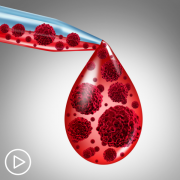
|
Transcript:
Katherine:
Once on therapy, how is the disease monitored, and how do you know if the treatment is working?
Dr. Fonseca:
Well, fortunately, we use the same markers. Once a person is in therapy, we will be monitoring. We monitor at least on a monthly basis of those myeloma protein markers. Once a person reaches a great level of response, sometimes we complement that with an analysis of the bone marrow. Of course, it’s more invasive, so we don’t like to do a lot of them, but we do them as needed. As we go forward and monitor patients, we will be looking for signs that those proteins remain in a low level as stable as an indicator that the disease is under control.
Now, if I saw someone and then I start seeing that there’s an increased concentration of those proteins or we see something else clinical, we might need to do a little bit of a regrouping and test again in great detail to determine if the person is experiencing regrowth and the disease is so-called relapsed.
Katherine:
Why is it so important for patients to speak up when it comes to symptoms or treatment side effects?
Dr. Fonseca:
Well, that’s a great question. If you don’t speak about them, we don’t know about them. It seems very obvious, but then we cannot make the proper adjustments. I’ll give you a couple of examples. I already talked about dexamethasone, but a common drug we use is something called bortezomib. Bortezomib is a proteasome inhibitor.
That’s a mouthful, but it’s one of the key type of drugs we use. It’s given as an injection under the skin. Not to be confused, by the way, with daratumumab. Faspro is the name of that medication, so not to be confused with that is bortezomib, which we have been using for many years.
Bortezomib has a potential toxicity that is called peripheral neuropathy. If patients have peripheral neuropathy, that can go from very mild where you have some numbness and tingling, to the more extreme cases that it’s associated with pain, discomfort, even weakness and disability.
Well, if we don’t know that’s happening, then we can’t react to it and we can’t adjust doses or switch to something different altogether. You can imagine now we have more options, but in the old days, I always tell patients, “You might be tempted not to say anything about this because you might be thinking, boy, this is working. I don’t want to interfere with my treatment. I can live with the peripheral neuropathy.” But if it gets worse, despite the fact that the treatment is working, the person might have a very significant impingement on their quality of life.
More so now that we have so many alternatives, it’s important not to get us into a path that we might reach a point of an irreversible chronic complication from treatment.
What Can Newly Diagnosed Myeloma Patients Expect When Starting Treatment?
What Can Newly Diagnosed Myeloma Patients Expect When Starting Treatment? from Patient Empowerment Network on Vimeo.
As a newly diagnosed multiple myeloma patient, the thought of treatment can be overwhelming. Expert Dr. Rafael Fonseca shares insight about expectations when starting a new treatment, and what goals providers have in mind for patient care.
Dr. Rafael Fonseca is the interim director of Mayo Clinic Cancer Center and serves as the director for Innovation and Transformational Relationships at Mayo Clinic in Arizona. Learn more about Dr. Fonseca here.
Related Programs:

|

|

|
Transcript:
Katherine:
Dr. Fonseca, we have a question from a newly diagnosed myeloma patient. Barbara says, “I am just about to begin my first myeloma treatment. What can I expect?”
Dr. Fonseca:
I think if you start on treatment, first of all I hope they already went through a good description of what the treatments are, the frequency by which you’re going to have to go to the center, and also what are the toxicities to look out for.
One of the most common toxicities that we face and one of the most challenging parts of initial treatment is the use of steroids. So, we use dexamethasone as part of every single regimen we use for myeloma. I tell patients, “Dexamethasone is a simple drug at first glance, but it’s oftentimes the most complicated part of treatment.”
The human brain works at triple speed when you’re on dexamethasone. So, it’s hard to sometimes be able to sleep properly. People can become anxious and even the sweetest person in the world can become a little bit edgy on dexamethasone.
I always say Mother Teresa on dexamethasone would be an edgy person. Just be patient. Work with the team. Just know that on the other side of treatment there is a return to normal life.
Our goal as we embark on treatments and, for instance, is I see patients that are going to go through transplant, I tell them, “Our goal is you finish, you recover, and you go back to your life. You back to work. You go back to your family, your kids, your sports.” That’s really what we strive for when we treat patients with myeloma.
What Key Questions Should Myeloma Patients Ask About Treatment?
What Key Questions Should Myeloma Patients Ask About Treatment? from Patient Empowerment Network on Vimeo.
Myeloma expert Dr. Rafael Fonseca shares specific questions that patients should ask about their treatment plan, and explains how to ensure optimal care for specific myeloma subtypes.
Dr. Rafael Fonseca is the interim director of Mayo Clinic Cancer Center and serves as the director for Innovation and Transformational Relationships at Mayo Clinic in Arizona. Learn more about Dr. Fonseca here.
Related Programs:
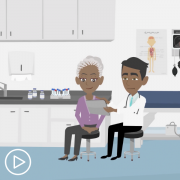
|
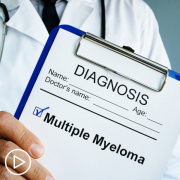
What Can Newly Diagnosed Myeloma Patients Expect When Starting Treatment? |

|
Transcript:
Katherine:
What sort of questions should patients consider asking about their treatment plan?
Dr. Fonseca:
I think it’s important that patients understand a few things. They can be described in multiple ways. Number one is, of course, what? What is it that is being used? I think that includes a description of what to expect, the practicalities, the names of the medications, their side effect profile, and what to report when you use those medicines. I think that’s very important because if you’re empowered with that information, you’re going to be better off as you react for symptoms that may come along. I always tell patients when you have a cancer diagnosis, your self-awareness goes through the roof because we’re going to be paying attention to everything, every skin change, every pain we have.
So, I think having a bit of that proactive discussion becomes important as they think about the treatments that they want. I think the how-to on the practicalities are very important. The best where the nursing team and the pharmacists help us a lot too. Do you take the medicines at night? Do you take them with meals? Is there something that you shouldn’t be mixing? How much time would it take for me to get a refill? It’s different to get a medication from a specialty pharmacy versus your down-the-street Walgreens. So, all of those things are important that patients, again, participate in the understanding.
If not them, at least the caregivers that are a part of this team. I think it’s important that patients ask also some brief descriptions of (A) the biology of the disease. If I have myeloma, what type of myeloma do I have? Does that matter as far as what treatments I’m going to be using? What treatment options may be available to me because of my specific subtype? We have subsets of myeloma that have options that are not available to others.
Also, I think it’s important that patients also ask a sense from the physicians as to where they are. I’d like to describe this a little bit more. Sometimes, patients ask us specific questions about, am I in a complete response? Am I in a very good partial response? What is a PFS? Those terms work very well when we talk about clinical trials, but they don’t necessarily describe in a great way the situation for an individual patient. I’d use a lot more objectives than I’d use technical terms when I describe where patients are. I say, “You have an excellent response. You have a very deep response.”
Then I’d provide more details if they want. “Yes, you’re MRD-negative at 10 to the -6.” But sometimes I find that it’s harder for patients to understand where they are if they completely focus on the staging system or the response criteria, etc.
Because maybe a VGPR, a very good partial response, doesn’t sound very good.
But then you can be in a very good partial response for 15 years and it doesn’t matter. You my want to be in an MRD-negative status, but you still have a good outcome. That’s why the general description of the status by a physician becomes important.
Katherine:
Do you think patients should get a second opinion consult with a specialist?
Dr. Fonseca:
In general, my answer is going to be yes. This is not self-serving. I think myeloma has become so complex that trying to integrate at least once, or if not, in some infrequent basis, an opinion of a myeloma specialist becomes important. This is no one’s fault. If you’re a community oncologist somewhere where myeloma represents only a small fraction of your practice, I can guarantee you, you cannot stay on top of the literature. I cannot stay up with everything that goes on with myeloma, even though that’s what I do 100 percent of the time.
I get an email every week with all the articles, all the publications, and I have to integrate that. I have to think, okay, does this matter or not? I go to the professional meetings. I see all the abstracts and I still feel like I’m missing out. How could you do that if that is only a small fraction of your practice? I’m sure that the same applies for other cancers, breast and colon. You can’t move. You cannot uproot yourself and leave your community and your family, but I think there should be ways by which patients at least have an opinion from someone who has more expertise. Fortunately, there are many centers across the nation now that have that expertise for the management of myeloma.



